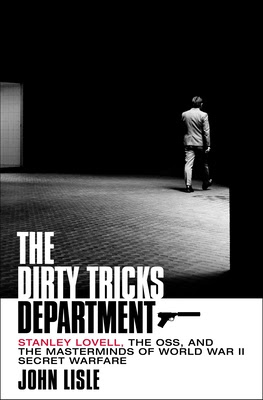I read a lot of WWII fiction but I've been trying to pick up some nonfiction books about that period in history as I'm discovering a lot of the events were never covered in my history classes. The Dirty Tricks Department is about the OSS (the forerunner to the CIA), Stanley Lovell (the head of the R&D Branch), and their contributions to the war effort.
Amazon affiliate links are used on this site. A free book was provided for an honest review.
 |
| March 2023; St. Martin's; St. Martin's audio, ebook, print (352 pages); history |
The book started off a little slowly as the men who ran the OSS are introduced. I worried that this was going to be too much of a textbook-type history book. But once the people were established, Lisle incorporated more anecdotes that broke up the facts. It never read like a novel, but some of the ideas that they came up with were so far out there that it was almost entertaining at times.
If you like history then this is definitely a book for you. However, I also think writers should add this book to their reference shelves. And I don't think it is just historical fiction writers that would find the information useful. There is definitely some good jumping off points for alternate history writers as well as dystopian and science fiction writers.
In reading WWII fiction, I realize I know very little about what was happening in the Pacific Theater. his book provided quite a few details about the challenges soldiers faced there.
I really liked the chapters about OSS's espionage efforts - documents, cover stories, and characters that they had to develop as well as some of the tactics employed by the spies. It really was the beginnings of the spycraft that I so love reading about in Cold War fiction. In these chapters, a few more names I recognized from my other reading popped up.
According to my Kindle, the main text is only about 63% of the book. The other 37% is made up of appendices (one which includes a soldiers' account in the Pacific which couldn't be fit in the main text), a bibliography (always a great resource for writers), and footnotes that provide more context to the information Lisle included in the main text.
I learned a lot by reading this book. Some of the information I had been aware of because of its use in novels I've read, but this book provided more background. But more often it was history that I had never been taught.
While it is focused mostly on the WWII years (the OSS was disbanded after the war and Stanley Lovell had been on family medical leave at the end the war), I liked that bridged the OSS time to the start-up of the CIA and how some of the projects OSS had been working on eventually become CIA projects.
Buy The Dirty Tricks Department at Amazon
Donna Huber is an avid reader and natural encourager. She is the founder of Girl Who Reads and the author of how-to marketing book Secrets to a Successful Blog Tour.
Enjoyed this post? Never miss out on future posts by following us. Get even more book news in your inbox, sign up for our newsletter today! Girl Who Reads is an Amazon advertising affiliate; a small commission is earned when purchases are made at Amazon using any Amazon links on this site. Thank you for supporting Girl Who Reads.



















0 comments:
Post a Comment